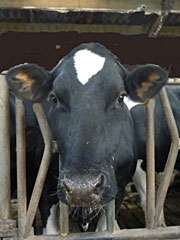Neutrons used to study a key protein in milk

Martha, a cow placidly grazing in a field in The Netherlands, became an important collaborator with researchers who successfully analyzed and characterized the internal protein structure and the composite particles of her milk using small-angle neutron scattering at DOE's Oak Ridge National Laboratory.
Casein micelles, a family of related phosphorus-containing proteins, make up 80 percent of the protein in cow milk. They are the building blocks of dairy products such as yogurt and cheese, supplying amino acids, calcium, and phosphorus to the body. More important, they are the principal vehicle for delivering calcium phosphate to rapidly growing newborns.
Researchers have long struggled with the challenge of unraveling the internal structure of this protein. An international collaboration used the's High Flux Isotope Reactor's (HFIR) general purpose small-angle neutron scattering instrument (GP-SANS) to study samples of milk from Martha. They compared the neutron scattering data with various theoretical models of casein structure that have been proposed in the literature. The results showed that one model prevails: The casein micelle proteins are composed of a protein matrix in which calcium phosphate nanoclusters (about 300 per casein micelle) are dispersed.
Provided by Oak Ridge National Laboratory


















